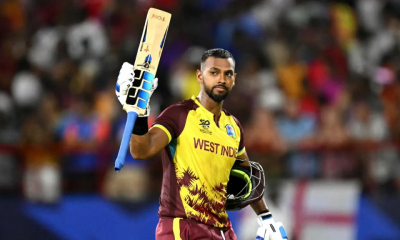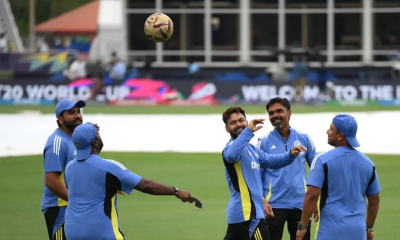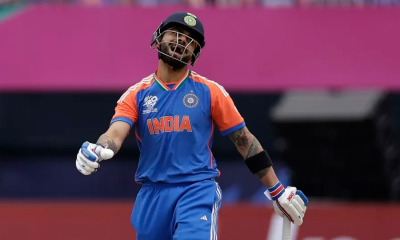Latest News
Suryakumar’s 83 pulls one back for India
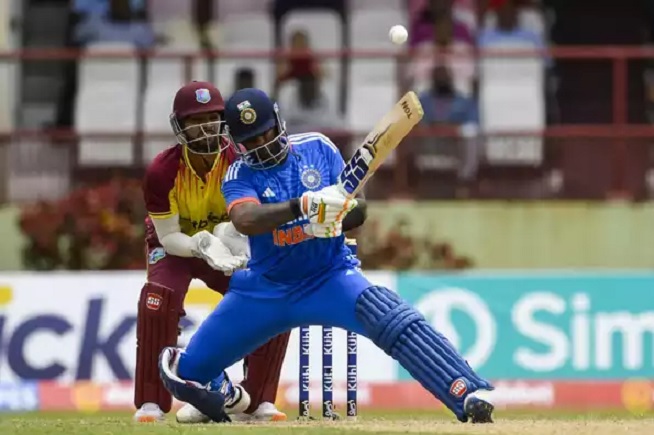
A relentless Suryakumar Yadav denied West Indies the opportunity to wrap up the five-match T20I series before it shifted base to the United States as his 44-ball 83 was pivotal in India’s comfortable seven-wicket win in chase of 159/5. Suryakumar had Tilak Varma for company, who carried on from his fifty in the previous game to get an unbeaten 49 off 37 and see off the chase after the former’s dismissal.
Suryakumar walked out to bat on the fifth ball of the first over after debutant Yashasvi Jaiswal miscued a big shot across the line on a slower ball from Obed McCoy. Suryakumar straightaway laid down his murderous intention for the evening by whipping the first ball he faced for a four over mid-wicket and then followed it up with a pull over square leg for a six. He then went down on one knee against Akeal Hosein, shaping up to play a sweep but instead sliced it over point.
Alzarri Joseph dented India for the second time in the Power-Play when he dismissed Shubman Gill but Tilak Varma walked out and sang a similar tune to Suryakumar. The first two balls he faced were both hit for fours – through extra cover and then over short third man. The duo then took McCoy apart in the last over of the PowerPlay to take India to 60/2 in 6 overs.
Tilak camped at the non-striker’s end to watch a familiar carnage unfold as Suryakumar continued to play his shots and reached his 50 in just 23 balls. Even as a drizzle came around, there was no respite for the West Indies bowlers as Suryakumar was in sublime touch, unfurling one audacious stroke after another. Romario Shepherd attempted to change the course of the game by taking the pace off the ball against the swashbuckler but in vain as Suryakumar saw through and found ways to shift across and hit him over fine leg as well as backward point. India coasted to 97 for 2 in 10 overs, the asking rate dragged down to just 6.30 an over.
Suryakumar’s urgency to get India on the series scoresheet meant India were well ahead of the DLS par score, if rain made a bigger intervention than just the drizzle that was around. Suryakumar looked on course to even get a hundred before polishing off the chase when he perished to an innocuous leg side ball that he flicked with all his might straight to Brandon King at fine leg.
Tilak took control following Suryakumar’s exit and ensured there were no late slip ups like they’d crept in, in the opening game of the series. Tilak finished one short of a second successive T20I fifty as Hardik Pandya completed the chase with a six down the track off Powell in the 18th over.
Hardik Pandya used four overs of spin in the Power-Play to put the West Indian top-order off their game. They responded by hitting each of India’s three spinners for a four or a six off the first ball of their respective opening overs (including Kuldeep Yadav’s over in the seventh) to stamp their authority. They reached 38/0 in 6 overs, with 29 of those coming from four overs of spin.
The next fours overs, also all spin, fetched 35 runs for the loss of Kyle Mayers’s wicket, taking West Indies to 73/1 in 10 overs.
West Indies’ most exciting batter in the format walked out to face Kuldeep, who’d just trapped Johnson Charles leg before and sent him packing with an excellent review. On the second ball he faced from the wrist spinner, he danced down the track, only to york himself. He repeated it just the next ball, and connected to smash a six over long-on and then premeditated a switch hit to cart a leg side ball over extra cover. Pooran’s adventurous attempts to throw Kuldeep off his rhythm brought his downfall as the next time he stepped out to play a big shot, he missed and was stumped in the 15th over.
Kuldeep turned the screws further on West Indies by ending Brandon King’s stay for a run-a-ball 42 as the opener reached out to a ball that was outside the off-stump and turned further away and hit it straight back to the bowler.
West Indies got 10, 8, 17 and 11 in the last four overs with Powell finishing with an unbeaten 40 off just 19 balls to carry his side past the 150-run mark. Powell was particularly disdainful against Arshdeep Singh, starting off with a six over extra cover at the start of the 19th over. Arshdeep missed with his attempted wide yorkers, conceded extras as well as another six in the expensive over. Mukesh Kumar, who was bowling just his second over of the game and the last of the innings, was hit for a big six in the 11-run over. Powell’s efforts took West Indies to a sizeable total, which Suryakumar picked apart expertly in chase.
Business
Trump heads to Saudi Arabia eyeing more investment in US

With US President Donald Trump due to visit Gulf states this week, a key focus will be securing significant new investment for the US economy.
“President Trump wants the announcement [of more Gulf money for the US],” says economist Karen Young, a senior fellow at the Middle East Institute think tank.
“He wants to have a big poster in a meeting that describes where these investments might go. And some estimation of what they will do to the American economy in terms of job creation or his big push, of course, on domestic manufacturing.”
Trump is due to arrive in the Saudi capital, Riyadh, on Tuesday 13 May, to meet the country’s de facto leader Crown Prince Mohammed bin Salman.
Trump is then expected to attend a summit of Gulf leaders in the city on 14 May, before travelling to Qatar that same day, and then ending his three-day trip in the United Arab Emirates (UAE) on 15 May.
The economic importance of the region to Trump is highlighted by the fact that the visit to Saudi Arabia was due to be the first overseas trip of his second term in the White House. That was before the death of Pope Francis necessitated Trump attending his funeral in Rome towards the end of April.
Saudi Arabia was also the first country that Trump visited during his first term of office, going against the modern practise of US presidents to start with the UK, Canada or Mexico.
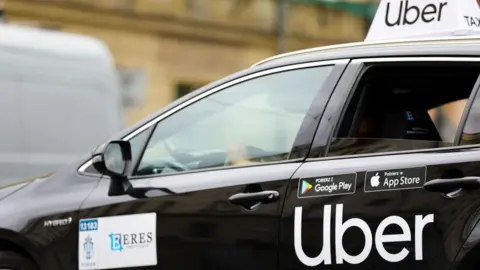
Securing new investments in the US from Gulf states, and particularly from their state-backed sovereign wealth funds, will help Trump to signal back home that his “America First” agenda is delivering results.
The presidential visit is drawing top Wall Street and Silicon Valley leaders to Saudi Arabia. A Saudi-US investment forum on 13 May in Riyadh will feature CEOs from BlackRock, Palantir, Citigroup, IBM, Qualcomm, Alphabet, and Franklin Templeton.
The push comes amid economic headwinds, as President Trump’s new import tariffs have significantly disrupted global trade, confidence, and the US economy itself. US economic output fell in the first three months of this year, its first fall in three years.
Back in January, Prince Mohammed said that Saudi Arabia would invest $600bn (£450bn) in the US over the next years. However, Trump has already said that he’d like that to rise to $ 1tn, including purchases of more US military equipment.
According to Ali Shihabi – a Saudi commentator and author, with close ties to the Saudi government – a number of economic agreements will be signed during the trip.
“These deals will further integrate the Saudi and US economies together, joint ventures in the kingdom, in the United States, procurements of American weapons and goods,” says Mr Shihabi.
Saudi Arabia’s sovereign wealth fund, the Public Investment fund (PIF), which controls assets worth $925bn, already has numerous investments in the US. These include Uber, gaming firm Electronic Arts, and electric car firm Lucid.
Meanwhile, the UAE has already committed to investing $1.4tn in the US over the next 10 years, in sectors such as AI, semiconductors, energy and manufacturing. This was announced by the White House in March after the UAE’s national security advisor, Sheikh Tahnoon bin Zayed Al Nahyan, met President Trump in Washington.
Yet Ms Young from the Middle East Institute says that the scale of these investments is not realistic in the short term. She instead says that they are long-term strategic moves, and that the figures should be taken “with a little bit of a grain of salt”.
Regarding specific deals that could be announced during Trump’s visit, it is widely reported that Saudi Arabia will agree to buy more than $100bn of US arms and other military items.
These are said to include missiles, radar systems and transport aircraft.
The US has been a longstanding arms supplier to Saudi Arabia, but in 2021 the then Biden administration stopped selling Riyadh offensive weapons, citing concerns about the country’s role in the war in neighbouring Yemen.
The 2018 killing of Saudi journalist Jamal Khashoggi was also widely reported to be a factor. A US report said that Prince Mohammed had approved the murder.
The Biden White House resumed the sale of these weapons last year. While it cited that the Saudis had stopped bombing Yemen, some commentators said that the US was seeking Saudi assistance to help end the conflict in Gaza and aid its future reconstruction.

Mr Shihabi says Saudi Arabia will be seeking assurances from the White House that the US will implement a “more efficient procurement system”, enabling the Gulf state to access ammunition and military equipment far more quickly and easily.
“The Trump administration is initiating procedures to facilitate those deals. So, it’s expected that this process will improve immediately,” he adds.
Artificial intelligence is the other topic that will dominate the agenda during Mr Trump’s visit. Talks are expected to centre on attracting greater Gulf investment into US tech firms, and boosting the region’s access to cutting-edge American semiconductors.
The UAE and Saudi Arabia have been investing billions of dollars into tech and AI sectors as try to diversify their economies away from oil.
The Emiratis, in particular, are keen to establish themselves as a global AI hub.
Last week, the Trump administration scrapped the Biden-era chip regulations that placed restrictions on exports of advanced US chips to more than 120 countries including the Gulf states.
The White House is expected to draft new rules that would potentially involve direct negotiations with countries like the UAE.
“For the UAE, this is absolutely essential,” says Ms Young. “They are aggressively building out their AI capacity. So, for them getting access to US technology is imperative to be the best.”
While much attention will be on Trump courting Gulf capital for the US, Saudi Arabia is equally focused on drawing American investment into its ambitious Vision 2030 program.
Led by giant construction projects, such as the building of a linear city called The Line, Vision 2030 is central to the Saudi government’s continuing efforts to diversify the country’s economy away from oil.
It also involves pouring resources into entertainment, tourism, mining and sports.
However, foreign direct investment into Saudi Arabia declined for a third straight year in 2024, reflecting persistent challenges in attracting overseas capital.
The fall in global oil prices since the start of the year has further strained Riyadh’s finances, increasing pressure to either raise debt or cut spending to sustain its development goals.
Oil prices tumbled to a four-year low amid growing concerns that a trade war could dampen global economic growth.
The decline was further fuelled by the group of oil producing nations, Opec+, announcing plans to increase output.
Saudi Arabia is part of that group, and some commentators said that the rise was in part a desire to please Trump who has called for lower oil prices.
Other analysts said the reason was more that Opec+ remains confident that the global economy is growing.
The US-Saudi Business Council, is an organisation that aims to boost trade ties between the two countries.
It is hoping that Trump’s visit will push American businesses to explore more opportunities in Saudi Arabia, especially in sectors like AI, healthcare and education.
“The Saudi government is looking heavily to invest in these sectors. There is a very big appetite for Saudi companies to collaborate with American companies,” Hutham Al Jalal, who heads the Riyadh office for the organisation, tells the BBC.
Saudi officials are said to be confident that some deals in these sectors will be secured during Trump’s visit.
For Saudi Arabia, Trump’s visit is about strengthening ties with their longest-standing Western ally – a relationship that grew strained during the Biden years. For President Trump, it is about landing investment deals that can be framed as a win for his economic agenda.
“President Trump is looking for a headline of big investments in America, and he will get that from this trip,” adds Mr Shihabi.
[BBC]
Latest News
Pope Leo urges release of imprisoned journalists in first news conference

Pope Leo XIV demands the release of imprisoned journalists in the first news conference of his pontificate
Addressing the world’s media in Vatican City, he says he reiterates the Church’s solidarity with them for “seeking the truth” He also calls for “the precious gift of free speech” to be safeguarded, and adds: “Let us disarm words…so we can disarm the world”
[BBC]
Latest News
US and China agree to slash tariffs for 90 days

The US and China have agreed a deal that will significantly cut the import tariffs, or taxes, both sides have imposed on one another for a 90-day period.
US Treasury Secretary Scott Bessent said both countries would lower their reciprocal tariffs by 115% for 90 days.
The announcement came after the two countries held talks in Switzerland, the first between the two countries since US President Donald Trump had levied steep tariffs on Chinese imports.
The huge tariffs caused turmoil in the financial markets and sparked fears of a global recession.
President Trump had imposed a 145% tariff on Chinese imports, while Beijing responded with a 125% levy on some US goods.
However, the US tariffs on Chinese imports will now be cut to 30% for 90 days, while Chinese tariffs on US imports will be cut to 10% for the same period of time. The pause will begin on 14 May.
The US measures still include an extra component aimed at putting pressure on Beijing to do more to curb the illegal trade in fentanyl, a powerful opioid drug.
The imposition of the tariffs had raised the prospect of trade between the two countries slumping, with US ports reporting a sharp drop in the number of ships scheduled to arrive from China.
Meanwhile Beijing has become increasingly concerned about the impact the tariffs could have on its economy. Factory output has already slowed and there are reports some firms were having to lay off workers as production lines of goods bound for the US began to grind to a halt.
Announcing the agreement, Bessent said: “The consensus from both delegations this weekend is neither side wants a decoupling.
“What had occurred with these very high tariffs was the equivalent of an embargo, and neither side wants that.
“We do want trade, we want more balanced trade, and I think that both sides are committed to achieving that.”
China’s commerce ministry said the agreement reached with the US was an important step to “resolve differences” and “lay the foundation to bridge differences and deepen co-operation”.
News of the agreement boosted stock markets, with Hong Kong’s benchmark Hang Seng Index ending the day up 3%. China’s Shanghai Composite Index had closed before details of the deal came out, and ended 0.8% higher.
European stocks rose in early trade and early indications were that the main US stock markets will open up by 2-3%.
[BBC]
-

 Business7 days ago
Business7 days agoAitken Spence Travels continues its leadership as the only Travelife-Certified DMC in Sri Lanka
-

 Latest News5 days ago
Latest News5 days agoNPP win Maharagama Urban Council
-

 Business7 days ago
Business7 days agoLinearSix and InsureMO® expand partnership
-

 Features2 days ago
Features2 days agoSAITM Graduates Overcome Adversity, Excel Despite Challenges
-

 Business5 days ago
Business5 days agoJohn Keells Properties and MullenLowe unveil “Minutes Away”
-

 Sports2 days ago
Sports2 days agoASBC Asian U22 and Youth Boxing Championships from Monday
-

 News2 days ago
News2 days agoDestined to be pope:Brother says Leo XIV always wanted to be a priest
-

 Foreign News3 days ago
Foreign News3 days agoMexico sues Google over ‘Gulf of America’ name change



